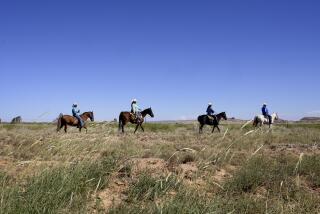Relocation Deadline Arrives but Navajo Have Won Reprieve
PHOENIX â For years this date--July 6, 1986--has loomed ominously in the future for a band of thousands of Navajo Indians: It was to be the deadline for them to vacate 900,000 acres of land in northeast Arizona that the courts and Congress had awarded to the neighboring Hopi Indians.
That future is here, but the Navajo have won a reprieve from the threat of immediate eviction.
Federal officials overseeing the relocation of the Navajo and officials of both tribes say that when the sun rises over the rugged and stingy land on Monday, the hundreds of Navajo families remaining on the Hopi land will still be there.
1.8 Million Acres
âJust another day,â Ralph A. Watkins Jr., chairman of the Navajo and Hopi Indian Relocation Commission, says of a date that once promised to be a deadline for disastrous dislocation for many Navajo. The commission has overseen the relocation of thousands of residents who found themselves on the wrong tribal lands when 1.8 million acres of disputed land was divided equally between the Navajo and the Hopi tribes.
âJuly 6 is going to come and go . . . and thereâs going to be nothing happening,â says Ivan Sydney, the Hopi tribal chairman.
While there has been a reprieve for the Navajo, the uneventful passing of the deadline means justice delayed and justice denied to the Hopi, who have lost tens of thousands of acres of their original reservation lands to the encroaching Navajo. To them, the passage of todayâs deadline with Navajo remaining on Hopi land is but another broken white promise.
âIt is the white man who has failed to . . . confine the Navajo on their reservation,â Sydney said. âThe Hopis really are the victims of the American system they believed in.â
Housing Required
The abrogation of the deadline was set in motion last December when Congress declared that no Navajos could be removed from the Hopi lands unless a suitable house had been built to resettle them in. With a woeful backlog of Navajos awaiting new homes, the effect was an indefinite delay--perhaps a year, by Watkinsâ estimate.
âIn effect, itâs an extension of the deadline,â says Rodger Boyd, director of intergovernmental relations for the Navajo tribal chairmanâs office.
The congressional edict was but another turn of events in the long history of the Navajo-Hopi land dispute. A peaceful people, the Hopi had never been at war with the United States and thus never signed a treaty, so their 2.5 million-acre reservation was created in 1882 by a presidential decree. The executive order empowered the secretary of the Interior to allow other Indians to live on the Hopi reservation âas (he) may see fit to settle thereon.â
Haunts the Hopi
It was boilerplate language that would haunt the Hopi years later, when they went to court to end decades of conflict with and encroachment by Navajos, complaints the federal government had ignored. In 1962, a three-judge federal court ruled that by not acting on the Hopi complaints, the government had, in effect, âsettledâ Navajos on Hopi lands.
The result: 1.8 million acres--more than two-thirds of the original Hopi reservation--was declared a âjoint use areaâ for both tribes. A federal judge eventually divided it equally between the two tribes, and with the drawing of that line about 100 Hopis found themselves living on Navajo land and about 12,000 Navajos on Hopi land.
In 1974, Congress ordered the relocation of those living on the wrong tribal lands. The Hopi were quickly resettled, but for many Navajo relocation was painful and disastrous. Some were given substandard housing, others lost their government provided homes in unscrupulous real estate deals, and many suffered family and mental problems.
Many Eager
Yet congressional investigators have found that many were eager to take advantage of the government offer of a new home, anywhere they choose, and a bonus payment of up to $5,000. The relocation commission, Watkins said, has settled Navajos âin Flagstaff, Phoenix, Los Angeles--weâve got one in Maine.â
All told, the relocation commission says about 2,600 families were eligible for relocation; about 1,000 have been relocated. Of the rest, about 250 to 300 still live on land awarded to the Hopi, the commission says. At an average family size of 4.3, 1,000 to 1,300 people must still be moved off Hopi land to new residences.
The remaining 1,300 families are in limbo: They do not live on the contested Hopi lands, but because of funding limitations they have not received their new home and bonus payment.
âThatâs a horrendous situation,â Boyd, of the Navajo chairmanâs office, says of those half-relocated. He also says that more residents still live on Hopi land than the commission estimates.
âSurvival Campâ
How many would openly resist forced eviction is in dispute, but scores of non-Navajo and non-Indians have gone to a âsurvival campâ in the Big Mountain area to show solidarity with them. There have been fears of violence in the event of forced evictions. âThereâs a lot of people out there for the last several months anticipating eviction,â says Boyd. âUnfortunately, theyâve been misinformed.â
But this weekend was expected to bring feasting and celebrations of victory by both sides: to the Navajo because they remain on the land they worship, to the Hopi because all legal efforts to allow Navajo to remain longer have been thwarted.
Lee Brooke Phillips, a lawyer with the Big Mountain Legal Defense-Offense Committee, a Flagstaff-based group fighting for repeal of the relocation act, says he accepts an estimate that perhaps 2,500 still live on Hopi land. He disagrees with Watkins that only 40 to 60 of the families are not willing to relocate.
âThe people there now intend to be there for the future,â Phillips said.
Worship the Land
There is agreement that for many of the traditionalists, such as older women who have lived for decades tending sheep on land they worship as part of their religion, relocation will be destructive. A U.S. House committee staff report has declared: âRelocation . . . is not simply a matter of changing residence. To the traditional Navajo family, it is the end of a way of life. . . . Relocation is complicated and can be tragic.â
The Big Mountain committee, nonetheless, has come under attack recently for allegedly exaggerating the relocation situation in its efforts to build nationwide support for repeal.
A recent benefit concert in Burbank, Calif., was billed as an attempt to âstop the forced relocation of 15,000 Navajo and Hopi Indians from their sacred lands.â
Living in Cities
Inevitably, some would have had to relocate anyway because of a lack of jobs, and the sparsely vegetated land could not support the livestock of thousands of Navajos, Boyd, of the Navajo chairmanâs office acknowledged. Paul Tessler, assistant director of the relocation committee, says some Navajos have maintained legal residence on Hopi land while actually living in distant cities.
Stunned by previous complaints of problems, the relocation commission is now turning to resettlement of Navajos, many of them elderly traditionalists living mostly off sheepherding, on so-called New Lands--250,000 acres of land purchased by the government for relocatees.
But the first New Lands construction, overseen by the Bureau of Indian Affairs, was as disastrous as previous efforts to build tract homes lacking power and water, which resulted in Navajo living in traditional hogans in the yards of their unused houses.
The Wrong Place
Now, the Bureau of Indian Affairs has built a house on an incorrect site--in the wrong place; drilled a water well that came up dry, and built a road that stopped one-half mile from the house. Total cost: $300,000.
âGovernment does not seem to learn,â Phillips said. âInstead of realizing the program doesnât work, they try to give it a new coat of paint. It reflects the fact that in Washingtonâs eyes, the only goal is to get people off the land without providing for them afterward.â
Watkins, the relocation commission chairman, estimates that by next June there will be enough houses for those still living on Hopi land, and that resettlement of those off the land but lacking new homes will take several more years.
âWannabe Tribeâ
Sydney, the Hopi chairman, says the tribe has no plans to evict from their land either the Navajo or their non-Navajo supporters, who have come to be derisively called the âWannabe Tribeâ--people who âwant to beâ Indians.
âThe Navajo must move themselves,â said Sydney, whose reservation is surrounded by the Navajo reservation. âIf the Navajo do not want to move off Hopi land they must come to the Hopi traditional leaders with their traditional leaders and ask.
âThey never have.â
More to Read
Sign up for Essential California
The most important California stories and recommendations in your inbox every morning.
You may occasionally receive promotional content from the Los Angeles Times.










